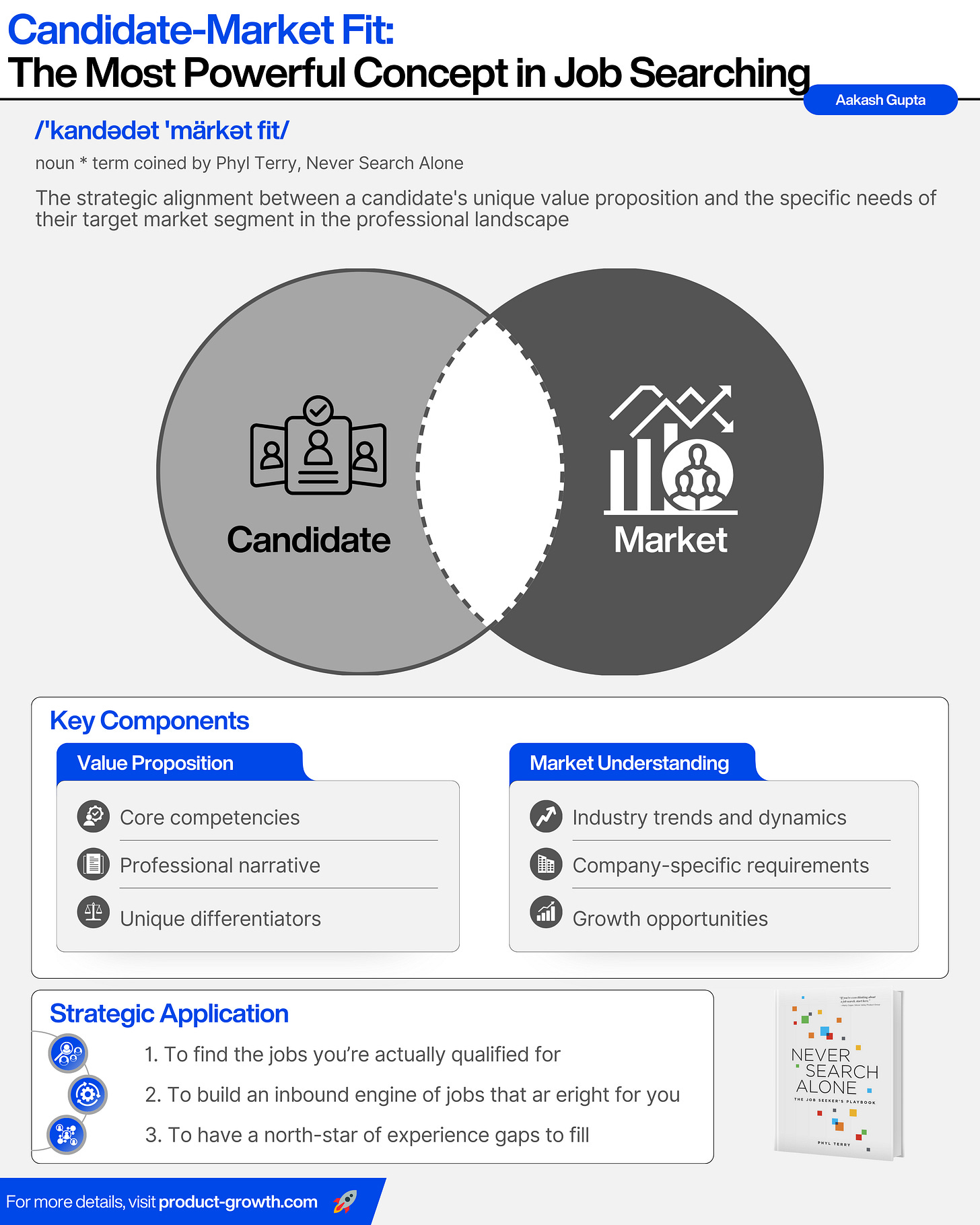Candidate-Market Fit for Job Seekers: Product Managers' Ultimate Guide
It might be the most important job searching concept you've never heard of. Here's everything you need to know about candidate-market fit - specifically applied for PMs, product leaders, and builders.
Perhaps the most powerful job searching concept ever is candidate-market fit (CMF).
It came out of Phyl Terry’s book Never Search Alone.
In it, Phyl describes how the key to finding a job is very similar to what we’ve been trained in product-market fit, but you replace the product with candidate:
This framing has resonated really strongly with product people (it helps relying on a product concept to start).
Resonate ≠ Easy
But, there is a lot of nuance for PMs to understand when it comes to candidate-market fit. In my conversations with PMs, I frequently find PMs misjudge their candidate-market fit.
Here are three recent conversations I had:
An aspiring PM doing his MBA at Duke had zero interviews. He’d applied for 1000s of PM postings, most of which require PM experience
A PM with 5+ years of experience in AI has only had 1 final round interview in three months, and no offer. She had applied to almost all AI PM openings
A PM with 15+ years of experience, 6 of them leading teams, hasn’t gotten any inbound in months
Each of these candidates had misjudged a different aspect of their Candidate-Market Fit.
Let’s learn what.
Today’s Deep Dive
This is the complete, practical guide to Candidate-Market Fit applied specifically to PMs that is going to help you win more interviews and job offers:
Signs that you need to evaluate your candidate market fit
How to fix your candidate-market fit as a PM
Advanced concepts no one tells you
6 real examples: CMF
1. Signs that you need to evaluate your candidate market fit
Not all job search problems are candidate-market fit problems. How do you know if you have a candidate-market fit problem specifically?
The first step to diagnosing it is a funnel view of your statistics. I like to focus on 5 key data points:
Once you have these statistics in hand, you can use the data to see if you fit into any one of these three main scenarios where you can attribute your problem to candidate-market fit.
Scenario 1: No Interviews
Let’s return to Candidate 1 from our intro.
Here was his funnel
Jobs Evaluated: 1100
Jobs Applied To: 1100
Interviews: 0
At this point, there are a few different options of what could be going wrong:
He could be applying poorly - eg, cold resumes
He may not be qualified enough
He may not have created a unification of his skills (candidate) with what the market wants
We looked at driver 1, and it wasn’t that. He was customizing his resume, getting referrals, and building work products.
We looked at driver 2, and it wasn’t that. He was a software engineer and project manager at a prominent semiconductor company before the MBA.
We realized it was driver 3, his candidate market fit. He wasn’t qualified for the jobs he was applying for.
Spoiler alert: he’s getting tons of interviews now.
Scenario 2: No Offers
You might think, if you are getting interviews, you’re all set.
You have candidate-market fit.
I’m sad to say that this is not the case.
Sometimes, what happens is that interview committee after interview committee keeps finding something out about you that results in not having offers.
I’ve seen two variants recently.
Variant 1 - If you are mainly getting first round interviews with recruiters
That was the case with candidate 2 from the intro.
She was getting that first round interview for her AI experience. But, beyond AI, she didn’t have experience in the specific industry folks were hiring in. So she was quickly excluded by recruiters.
You should be passing 90%+ of recruiter calls if you have candidate-position fit.
Variant 2 - If you are getting feedback that you did well in the interviews but they found a better candidate
This often makes you feel good. You did a good job. They just found someone better.
But it’s also an ominous sign.
Clearly, someone out there had better position-market fit for that position.
If you hear this often - someone else was better than you - then you probably have a broader candidate-market fit issue.
Scenario 3: No Inbound
The final way to know you have a problem with candidate-market fit is if you don’t get any inbound.
If you’re not getting inbound, it could be due to:
Bad LinkedIn
Not enough experience
Not enough candidate-market fit conveyed
So if you have optimized your LinkedIn and have some PM experience, it’s probably a candidate-market fit issue.
The fact is: if you’re an experienced PM with more than 3+ years of experience in a competitive job market, you should be getting inbound messages from recruiters.
If you’re not, it’s highly likely you have a candidate-market fit problem.
So, if you need to refine your candidate-market fit, how do you?
2. How to fix your candidate-market fit as a PM
Keep reading with a 7-day free trial
Subscribe to Product Growth to keep reading this post and get 7 days of free access to the full post archives.




